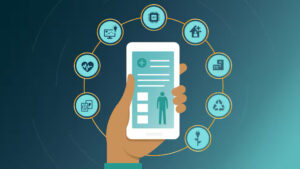In a world where technology shapes nearly every aspect of our lives, the idea of forming relationships with artificial intelligence (AI) is moving from science fiction to reality. AI companions, capable of offering emotional support, companionship, and even romantic connections, are gaining traction. This article explores why AI relationships may become a new social norm, examining the psychological, technological, and societal factors driving this shift, as well as the ethical challenges that accompany it. By understanding these dynamics, we can better navigate the evolving landscape of human-AI interactions.
The Emergence of AI Companions
AI companions have evolved from simple chatbots to sophisticated systems that mimic human-like interactions. Platforms like Replika and Character.AI have become popular for their ability to engage users in meaningful conversations. Replika, for instance, has built a loyal user base, with many describing their AI companions as friends or even romantic partners. Character.AI, which allows users to interact with AI-generated personas, handles 20,000 queries per second, reflecting significant user engagement Nature, 2025.
This rise in popularity suggests that AI relationships may become a new social norm. A 2024 survey by the Institute for Family Studies found that 1 in 4 young adults believe AI could replace human-to-human romantic relationships, while 1 in 10 are open to having an AI friend Institute for Family Studies, 2024. These statistics indicate a growing acceptance of AI in social roles, driven by its ability to provide consistent, tailored interactions.
Why People Are Drawn to AI Relationships
The appeal of AI relationships lies in their ability to meet fundamental human needs. Here are some key reasons why AI relationships may become a new social norm:
- Combating Loneliness: Loneliness is a significant public health issue, with studies linking social isolation to poor mental and physical health Hawkley and Cacioppo, 2003. AI companions offer a constant presence, particularly for those with limited social connections, such as the elderly or individuals in remote areas. For example, AI can provide emotional support for those hesitant to seek human help, improving mental well-being Our Mental Health, 2024.
- Convenience and Control: Unlike human relationships, which require compromise and effort, AI companions are available 24/7, tailored to user preferences, and free of emotional baggage. This convenience makes them appealing for those seeking low-maintenance companionship Forbes, 2024.
- Mental Health Support: AI platforms like Woebot and Wysa offer cognitive behavioral therapy techniques, mood tracking, and coping strategies. These tools serve as an accessible entry point for mental health support, especially for those reluctant to engage with traditional therapy Our Mental Health, 2024.
- Romantic Connections: In the realm of romance, some AI platforms cater to intimate needs. For instance, certain services provide 18+ AI chat features, allowing users to engage in adult-oriented conversations, which highlights the diverse roles AI can play in personal relationships Nature, 2025.
These factors demonstrate why AI relationships may become a new social norm, as they address emotional and practical needs in ways that human relationships sometimes cannot.
Technological Advancements Fueling the Trend
The rapid advancement of AI technology is a cornerstone of why AI relationships may become a new social norm. Innovations in natural language processing (NLP), machine learning, and neural networks enable AI to understand and respond to human emotions with increasing accuracy. These technologies allow AI companions to adapt to individual users, creating personalized interactions that feel authentic and engaging.
For example, AI systems can analyze user behavior to tailor responses, fostering a sense of continuity and irreplaceability. This personalization is key to why users perceive AI as relational partners rather than mere tools Nature, 2025. The availability of all AI tools, from virtual assistants like Siri to specialized companionship apps, further expands the scope of AI’s role in social interactions.
Looking ahead, future developments could make AI relationships even more immersive. Technologies like haptic feedback, improved speech synthesis, and integration with augmented or virtual reality (AR/VR) could create experiences that blur the lines between digital and physical companionship. These advancements suggest that AI relationships may become a new social norm as they become more lifelike and integrated into daily life.
Societal Shifts and Growing Acceptance
Societal changes are paving the way for AI relationships to become a new social norm. The rise in single-person households and weakening traditional family structures have created a void that AI companions can fill. In countries like Japan, where solitary lifestyles are increasingly common, AI is seen as a practical solution to social isolation Forbes, 2024.
Younger generations, particularly Millennials and Gen Z, are more open to digital companionship due to their familiarity with technology. Surveys indicate that 25% of young adults believe AI could replace traditional romantic relationships, reflecting a shift in how intimacy is defined Institute for Family Studies, 2024. As these generations gain influence, the stigma around AI relationships is likely to fade, further normalizing their place in society.
However, this shift is not without controversy. Some argue that prioritizing AI relationships could weaken human bonds, as nearly 70% of older adults in a 2024 survey expressed discomfort with AI being seen as equivalent to human relationships, particularly for vulnerable groups like dementia patients Psychology Today, 2025.
Ethical Challenges and Potential Risks
While the benefits of AI relationships are significant, they come with ethical and social challenges that must be addressed to ensure they contribute positively to society. Below is a table summarizing key risks and considerations:
| Risk | Description | Potential Impact |
| Unhealthy Dependencies | Over-reliance on AI for emotional support may lead to neglect of human relationships, potentially causing addiction-like behaviors Nature, 2025. | Increased social isolation and reduced real-world connections. |
| Unrealistic Expectations | AI’s seamless, conflict-free interactions may create expectations that human relationships cannot meet, leading to frustration Psychology Today, 2025. | Diminished patience for human relationships requiring effort. |
| Empathy Atrophy | Interactions with AI, which lack genuine emotions, may reduce users’ ability to empathize with others Psychology Today, 2025. | Weakened emotional intelligence and social skills. |
| Lack of Reciprocity | AI systems are primarily “givers,” offering support without requiring it in return, which may alter expectations for mutual support in human relationships arXiv, 2025. | Imbalanced relational dynamics. |
These risks highlight why AI relationships may become a new social norm only if accompanied by careful regulation. Researchers advocate for “socioaffective alignment,” where AI systems are designed to align with human values and promote healthy interactions. This involves not only technical advancements but also ethical guidelines to prevent harm and ensure AI enhances rather than replaces human connections Nature, 2025.
The Future of AI Relationships
The future of AI relationships is promising yet complex. As AI technology advances, companions will become more sophisticated, offering interactions that are increasingly indistinguishable from human ones. This could lead to a society where AI relationships are as commonplace as smartphones, integrated into daily life as assistants, friends, or even romantic partners.
However, achieving this future requires addressing ethical challenges. Establishing norms for human-AI interactions is crucial to ensure that AI enhances social connections without undermining human relationships. For example, guidelines could limit the extent to which AI mimics human emotions to prevent dependency, while educational campaigns could inform users about balancing AI and human interactions.
The potential for AI relationships to become a new social norm is evident in their growing integration into daily life. Platforms like Character.AI, with 1.4 million members in its Reddit community, demonstrate the scale of user engagement Nature, 2025. As AI continues to evolve, it may redefine intimacy, companionship, and social expectations, making AI relationships a standard part of our social fabric.
Conclusion
AI relationships may become a new social norm due to their ability to address loneliness, provide consistent emotional support, and leverage advanced technologies for personalized interactions. The growing acceptance among younger generations, coupled with societal shifts toward digital connectivity, supports this trend. However, the potential risks—unhealthy dependencies, unrealistic expectations, and empathy atrophy—require careful consideration to ensure AI enhances rather than replaces human connections.
By fostering socioaffective alignment and establishing ethical guidelines, we can navigate this evolving landscape thoughtfully. AI relationships offer a unique opportunity to enrich our social lives, but their success depends on balancing their benefits with the irreplaceable depth of human interaction. As we move forward, the question is not whether AI relationships will become a new social norm, but how we can integrate them responsibly to create a more connected, empathetic world.





